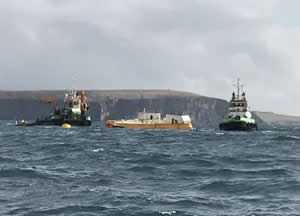Wello's Penguin WEC generates electricity at EMEC grid-connected wave test site
 From Power-Technology: High-technology company Wello’s Penguin wave energy converter (WEC) has successfully generated power into the national grid off the west coast of Orkney in Scotland, UK.
From Power-Technology: High-technology company Wello’s Penguin wave energy converter (WEC) has successfully generated power into the national grid off the west coast of Orkney in Scotland, UK.
At the beginning of March this year, the Penguin WEC was deployed by UK-based company Green Marine at the European Marine Energy Centre’s (EMEC) grid-connected wave test site at Billia Croo in Scotland.
As part of the Clean Energy from Ocean Waves (CEFOW) project, the device is the first of the three WECs due to be installed at EMEC over the next three years.
EMEC's managing director Neil Kermode said: “This is a tremendous milestone for Wello and all CEFOW partners, but also for the wave energy sector as a whole.
“Not only has Wello’s Penguin survived heavy swell and stormy conditions since being deployed, it is now generating power into the local grid.”
Led by electricity company Fortum, generation of energy is a major step within the CEFOW project. This aims to prepare the Penguin WEC technology for commercialisation by developing the first grid-connected wave energy array in the UK. Full Article:
Comments (0)
This post does not have any comments. Be the first to leave a comment below.
Featured Product

